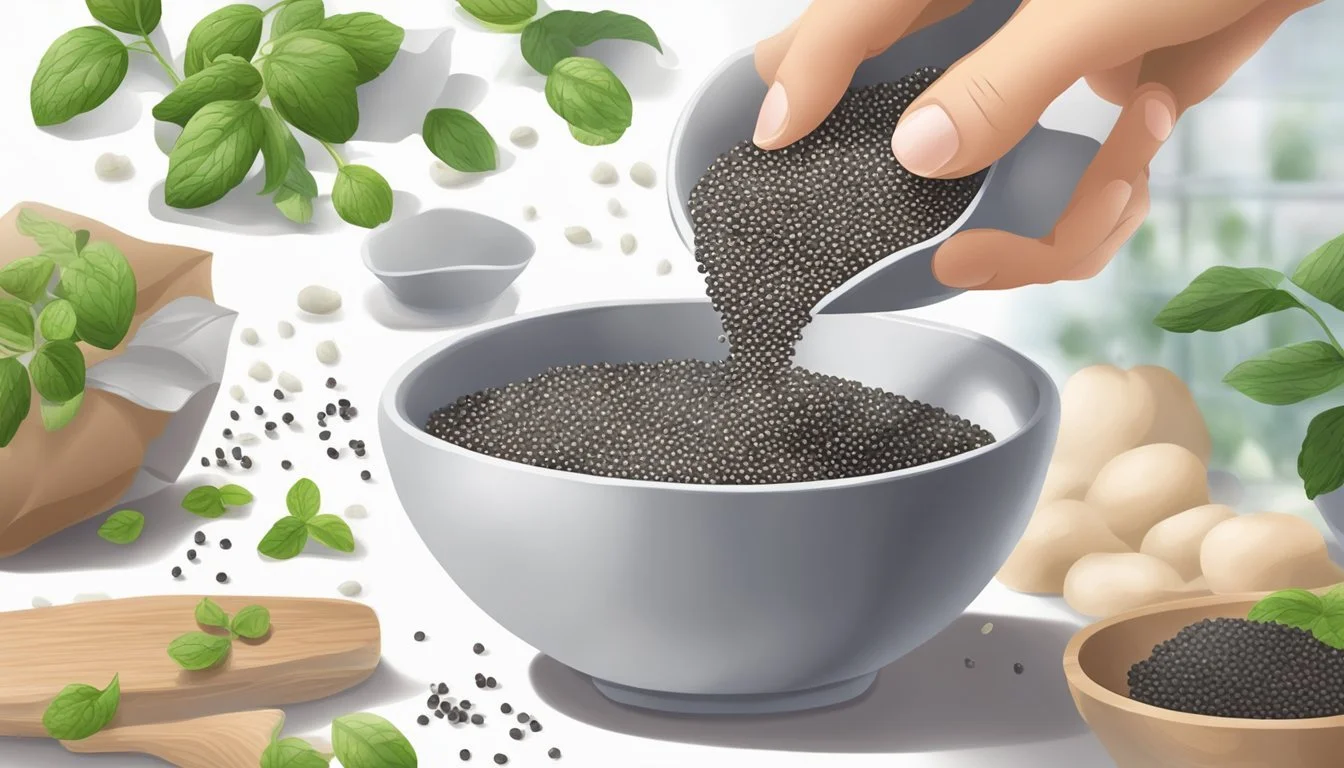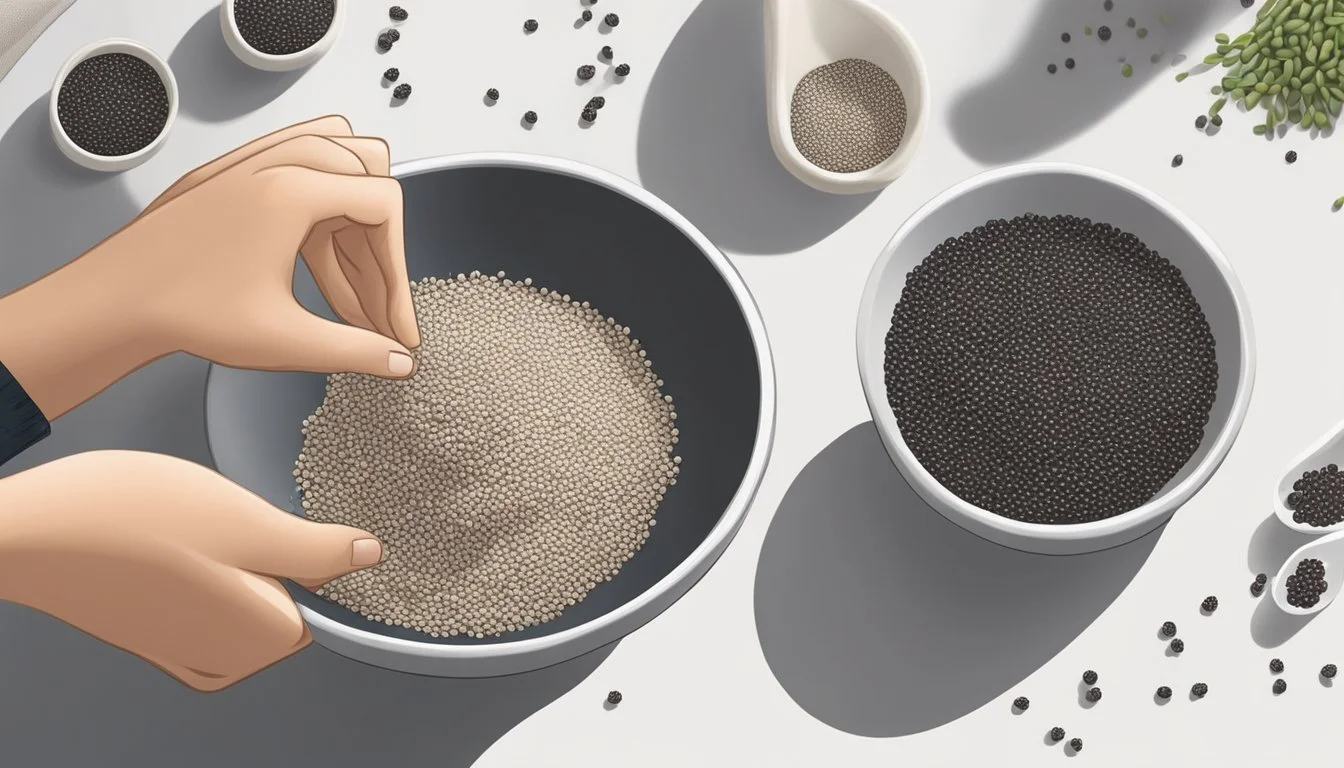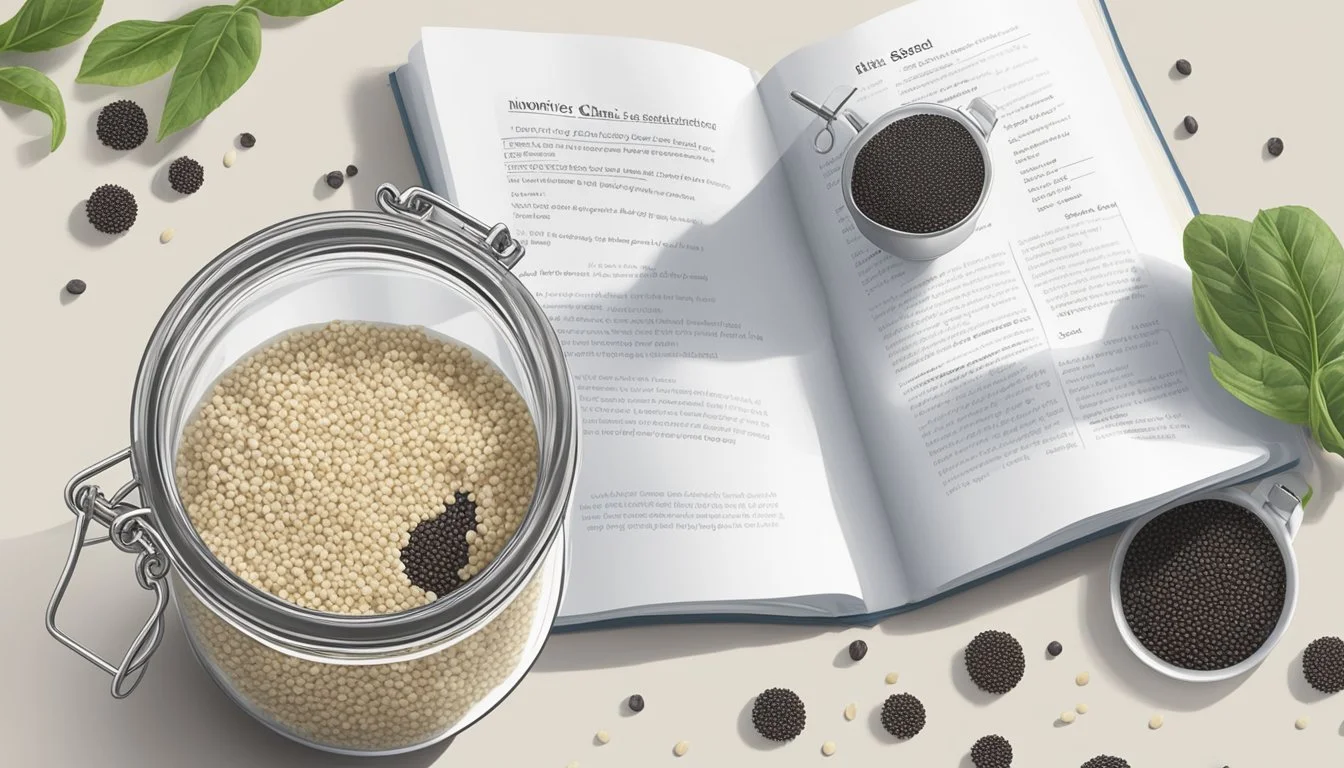How to Substitute White Chia Seeds for Black Chia Seeds
A Simple Guide
Chia seeds are a versatile and nutritious superfood that have gained popularity for their rich omega-3 fatty acid contents, dietary fibers, proteins, and antioxidants. They come in both black and white varieties, which are often used interchangeably in various recipes. While they are virtually identical in terms of nutrition, the black chia seeds are known to have a slightly higher protein content, which contributes to their essential amino acid profile.
Substituting white chia seeds for black chia seeds in recipes is straightforward due to their similar taste and texture. The difference in color may slightly alter the appearance of a dish, but it does not significantly impact the flavor or nutritional value. The seeds can be used to thicken smoothies, as a binding agent in baking, or to make the popular chia pudding by soaking them in a liquid like plant-based milk or coconut milk.
When it comes to incorporating them into meals, both white and black chia seeds can be sprinkled on salads, added to baked goods, or used as an egg replacement in vegan recipes. Chefs and home cooks alike appreciate the seeds' ability to provide a nutritional boost without compromising the integrity of the original dish. Regardless of the color, chia seeds offer a simple way to enhance the nutrient content of everyday foods.
Understanding Chia Seeds
Chia seeds, deriving from the plant Salvia hispanica, are recognized for their rich nutritional value and diverse usage in culinary practices. They have a storied history originating in Central America, where they were a staple in ancient civilizations' diets.
Nutritional Profile
Chia seeds are a powerhouse of nutrition, offering a dense profile of omega-3 fatty acids, fiber, protein, antioxidants, and a variety of essential minerals and vitamins. Specifically, they contain significant amounts of alpha-linolenic acid (ALA), a type of omega-3 fat. Here's a concise breakdown of their nutritional content per one ounce (approx. 28 grams):
Fiber: 11g
Protein: 4g
Omega-3 fatty acids: 5g
Fat: 9g (including omega-3s)
Calcium: 18% of the RDI
Magnesium: 30% of the RDI
Phosphorus: 27% of the RDI
Varieties and Characteristics
There are two main varieties of chia seeds: black and white. While both offer similar nutritional benefits, black chia seeds possess a marginally higher protein content, and white chia seeds have slightly more ALA omega-3 fatty acids. In terms of usage, they are interchangeable in recipes without compromising the nutritional value or overall outcome of the dish.
Black Chia Seeds: Tend to have a higher protein content.
White Chia Seeds: Often contain more ALA omega-3 fatty acids.
Historical Background
Chia seeds originate from Mexico and Guatemala and played a significant role in the diets of the Aztecs and other indigenous peoples of Central and South America. The seeds were highly valued for their medicinal properties and as a source of sustainable energy. The name "chia" is derived from the Nahuatl word "chian," meaning oily, which is fitting given their high beneficial fat content.
The Role of Chia Seeds in the Diet
Chia seeds serve as a versatile ingredient that can enhance the nutritional profile of a variety of dishes. They are particularly valued for their high protein content and presence of essential fatty acids.
Chia Seeds in Traditional Recipes
Chia seeds have been used in traditional recipes for centuries, especially in Central America where they were a staple food for the Aztecs and Mayans. One of the classic preparations was a drink known as "Chia Fresca," where chia seeds were mixed with water and lime juice. In traditional recipes, these tiny seeds serve both as a thickening agent and a source of sustained energy.
Modern Uses of Chia Seeds
In contemporary cooking, chia seeds are appreciated for their ability to absorb water or milk, creating a pudding-like consistency merely by soaking. This property has popularized chia pudding, a simple dish that can be flavored with a wide array of additives like fruits, nuts, and sweeteners. Chia seeds are also a common addition to smoothies for a nutrient boost, and they are incorporated into baked goods such as bread, muffins, and pancakes to improve their nutrient profile.
Recipes Incorporating Chia Seeds:
Overnight oats with a spoonful of chia for thickness
Cereal or granola enhanced with a sprinkling of seeds
Snack bars with chia for extra texture and protein
Chia Seeds as a Dietary Staple
Chia seeds have transcended their original use to become a dietary staple in many healthy eating plans. Their content of omega-3 fatty acids, protein, and fiber make them a nourishing addition to any meal or snack. They can easily be mix into granola, sprinkle atop cereal, or fold into batter for various baked goods, thus allowing for a seamless incorporation into daily cooking and snacking habits.
Substituting Chia Seeds
Chia seeds are valued for their nutritional benefits and versatility in cooking. This section explores why one might consider substituting between white and black chia seeds and how to do so effectively.
Why Substitute Chia Seeds?
Individuals may opt to substitute black chia seeds for white chia seeds or vice versa for a variety of reasons. White and black chia seeds offer a similar profile when it comes to nutrition and health benefits, including protein content, fatty acids, ALA (alpha-linolenic acid), calcium, magnesium, and essential amino acids which are beneficial for digestion and cholesterol management. The need to substitute typically arises from considerations of color, availability, or slight differences in taste and texture.
Comparison of White and Black Chia
Aspect White Chia Seeds Black Chia Seeds Color Lighter, more neutral Darker, more visible in foods Taste Subtly sweeter Nuttier, earthier Texture Similar gelling ability Similar gelling ability Nutrition Rich in ALA, protein, fatty acids, etc. Rich in ALA, protein, fatty acids, etc.
Though white and black chia seeds are nutritionally similar, the primary difference lies in their color. White seeds may be preferred for aesthetic reasons in certain dishes where a less visible seed is desirable. They are often described as having a subtly sweeter taste compared to the nuttier flavor of black chia seeds.
How to Substitute Seeds
When substituting one color chia seed for another, it's straightforward due to their comparable properties. A one-to-one ratio is recommended:
1 tablespoon of black chia seeds = 1 tablespoon of white chia seeds
The substitution has little impact on the final dish’s flavor or nutritional content, making it easy to interchange white and black chia seeds based on personal preference or recipe requirements. It's vital, however, to consider the final appearance of the dish as white chia seeds might create a more visually appealing presentation in lighter-colored foods.
Practical Tips for Using Chia Seeds
When substituting white chia seeds for black, one should keep in mind that the main differences are color and a slight variation in nutritional content; however, their use in recipes is virtually interchangeable. Here are practical tips to effectively use chia seeds in various applications.
Hydration and Soaking
Chia seeds possess the ability to absorb water and form a gel-like consistency. For optimal hydration, soak the seeds in a ratio of one part chia seeds to ten parts water for about 10 to 15 minutes. This pre-soaking step is crucial when incorporating chia seeds into puddings, jam, sauces, or smoothies, as it allows the seeds to fully expand and contribute to the desired texture.
Chia Seeds in Baking
Substituting chia seeds for eggs in baking recipes can add nutritional value and act as a binding agent. Prepare a chia egg by mixing one tablespoon of ground chia seeds with three tablespoons of water and let it sit until it achieves a gel-like texture. This substitute works well in muffins, bread, and cakes, contributing to moisture without altering the flavor significantly.
Creating a Balanced Flavor
Although chia seeds have a mild, nutty taste, they can influence the flavor profile of the dish subtly. To maintain a balanced taste, use chia seeds in moderation. They blend well with various ingredients in yogurt or baking recipes, enhancing the dish subtly without overwhelming other flavors.
Alternatives to Chia Seeds
When recipes call for chia seeds, several superfood alternatives can offer comparable nutritional benefits and are suited to various dishes. These substitutes also vary in cost and availability, allowing flexibility when shopping.
Other Superfood Seeds
Hemp Seeds: Known for their high protein content and omega-3 fatty acids, hemp seeds are a nutritious substitute for chia seeds.
Flaxseeds: With a high fiber content and essential omega-3s, ground flaxseeds can replace chia seeds, especially as a binding agent in recipes.
Sesame Seeds: A common ingredient with a nutty flavor, sesame seeds offer a significant amount of calcium and can be used in a variety of dishes.
Quinoa: While technically a seed, quinoa is used as a grain and is complete with all nine essential amino acids, making it a suitable alternative in meals for its protein content.
Sunflower Seeds: These seeds provide vitamin E and magnesium and can serve as a crunchy alternative.
Pumpkin Seeds: Also called pepitas, these seeds are rich in magnesium and can be used in place of chia seeds for their texture and nutrients.
Seed Substitute in Specific Dishes
Baking: Flaxseeds or eggs can serve as chia seed substitutes in baking, providing similar binding properties.
Salads: Sunflower seeds and pumpkin seeds add a savory crunch to salads and are a cost-effective option compared to chia seeds.
Yogurt Toppings: Hemp seeds, flaxseeds, or a sprinkle of quinoa can provide a fiber-rich and protein-packed addition to yogurt.
Considering Cost and Availability
Cost-Efficient: Sunflower and pumpkin seeds tend to be less expensive than chia seeds and are readily available in most grocery stores.
Niche Markets: While hemp seeds and quinoa may be pricier, these substitutes can be found in health food stores or purchased in bulk to reduce cost.
Local Availability: Sesame seeds are commonly found and can be an economical alternative, particularly in areas where chia seeds are more expensive or harder to source.
Health Considerations and Benefits
When substituting white chia seeds for black chia seeds, one can be assured that the health benefits remain substantial. Both varieties offer a rich array of nutrients that contribute to several aspects of health.
Digestive Health
White chia seeds are a robust source of dietary fiber, which includes both soluble and insoluble components. Soluble fiber assists in the absorption of water, forming a gel-like substance that aids in digestion. A serving of these seeds can facilitate bowel regularity and contribute to a healthy digestive tract.
Heart Health
The presence of omega-3 fatty acids in white chia seeds is key in promoting heart health. These essential fats are known to help reduce cholesterol levels, which can lead to improved cardiovascular function. Additionally, the antioxidants found in chia seeds support the body in combating oxidative stress, potentially lowering the risk of heart disease.
Bone Health
In terms of minerals, white chia seeds are a valuable source of calcium, magnesium, and phosphorus, all of which are vital for bone health. Their nutritional value underpins the maintenance of strong bones and may help prevent osteoporosis. The high protein content, along with essential amino acids, also supports muscle repair and growth, complements the benefits to bone health.
Innovative Recipes and Ideas
Substituting white chia seeds for black chia seeds can be seamless, as both variants have similar nutritional value and absorbency. The creative use of white chia seeds can add texture and nutrients to an array of dishes, from toppings to desserts.
Chia Seed Toppings
Adding white chia seeds as a topping on oats or yogurt amplifies both the nutritional content and texture. They provide a subtle crunch and a boost of omega-3 fatty acids, protein, and fiber. For a hint of nuttiness and extra texture, toast the seeds lightly before sprinkling them over your breakfast bowl. White chia seeds can also be used as a topping for baked goods, imparting a delicate, crunchy crust to muffins and bread.
Oatmeal: Sprinkle 1 tablespoon of white chia seeds on top of prepared oatmeal.
Yogurt Parfait: Layer yogurt with fruits like banana and blueberry, adding a tablespoon of chia seeds in each layer.
Smoothies and Beverages
White chia seeds blend well into smoothies and beverages without significantly altering the color. They contribute to the thickness and add essential nutrients. In a smoothie, blend 1 tablespoon of white chia seeds with your favorite fruits such as banana or blueberry, and milk of choice for a satisfying and nutritious drink.
Chia Fresca: Stir 2 teaspoons of white chia seeds into a glass of lemon water and let sit until it develops a gel-like consistency.
Berry Chia Smoothie: Combine 1 cup of mixed berries, 1 cup of milk, 1 frozen banana, and 2 tablespoons of white chia seeds in a blender until smooth.
Chia-Based Desserts
White chia seeds can create a visually appealing chia seed pudding while retaining all the benefits. They're equally absorbent, making the switch from black to white chia seeds simple. A basic chia pudding recipe involves soaking the seeds in milk until they swell to create a tapioca-like consistency.
Vanilla Chia Pudding: Mix 1/4 cup of white chia seeds with 1 cup of milk, 1 teaspoon of vanilla extract, and a sweetener of your choice. Refrigerate for a few hours until set.
Chocolate Chia Dessert: Blend 1/4 cup of white chia seeds with 1 cup of chocolate almond milk. Let it sit until it thickens, and top with chocolate shavings for an extra treat.
Conclusion
When substituting white chia seeds for black chia seeds, one can proceed with confidence. Both varieties have similar nutritional profiles, though black chia seeds have a marginally higher protein content. This difference is often negligible in the context of an overall diet. In culinary use, they can be interchangeable without materially altering the flavor or texture of a recipe.
Texture and Flavor:
Black chia seeds: Slightly crunchier with a neutral taste
White chia seeds: Similar texture with a subtly different flavor
They are both excellent sources of omega-3 fatty acids, fiber, and essential minerals. Here's a quick comparison:
Nutrient Black Chia Seeds White Chia Seeds Omega-3 Fatty Acids High High Fiber High High Protein Slightly Higher High Antioxidants High High
When using white chia seeds in a recipe that calls for black, or vice versa, there's no need to adjust the quantity. They both absorb liquid and swell to form a gel-like consistency in a similar manner.
Incorporating either type of chia seed into meals contributes to nutritional enrichment. Whether sprinkled on salads, blended into smoothies, or added into baked goods, the health benefits remain substantial. Consumers need not be hindered by the color of chia seed available—they can substitute white for black chia seeds seamlessly, maintaining the dish’s quality and nutritional value.
Frequently Asked Questions
In this section, the focus is on addressing common queries about white chia seeds as a substitute for black chia seeds, including their storage, efficacy in weight management, and use during pregnancy.
Storage and Shelf Life
When substituting white chia seeds for black, one should know that the storage requirements and shelf life are similar. Both varieties of chia seeds should be stored in a cool, dry place, and when stored properly, they can last up to two years. It is advisable to keep them in an airtight container to avoid moisture, which can spoil the seeds.
Chia Seeds for Weight Management
Chia seeds, irrespective of their color, are a beneficial addition to weight management diets. They are rich in fibers and proteins, which can help reduce appetite and promote satiety. For those looking to manage weight, incorporating chia seeds into meals can be a valuable strategy. However, one should remember that no single food can be responsible for weight loss; a balanced diet and regular exercise are crucial for effective weight management.
Usage During Pregnancy
Both black and white chia seeds can be a nutritious choice during pregnancy, providing omega-3 fatty acids, calcium, and protein, which are beneficial for fetal development. Pregnant individuals can include chia seeds in their diet with confidence. However, it is always recommended to consult a healthcare provider before making changes to the diet during pregnancy.
Chia seeds present an easy and nutritious addition to many meals, irrespective of the variety one chooses to incorporate.









